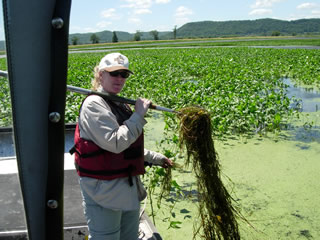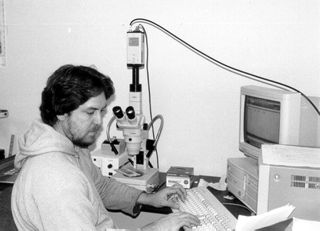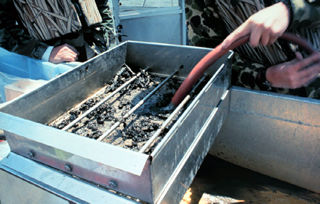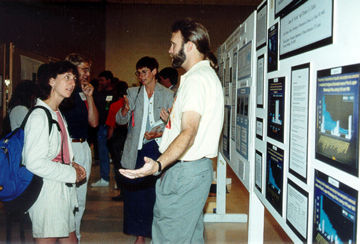 |
Upper Mississippi River Restoration ProgramLong Term Resource Monitoring |
|
 |
||
Cooperative Research
 Heidi Langrehr served as lead author on a peer-reviewed scientific paper with a diverse group of coauthors that included Dr. Brian Gray (USGS/UMESC) and Jeff Janvrin (WDNR, Mississippi River Team). The study evaluates aquatic vegetation response to an island-building habitat rehabilitation and enhancement project (HREP) in lower Pool 8, and includes data collected from Phase I and II of the Pool 8 Islands HREP as well as data from areas in lower Pool 8 that had no projects built. Results suggest island building is an effective tool to establish aquatic vegetation in impounded sections of the Mississippi River such as Lower Pool 8 where suitable fish and waterfowl habitat can otherwise be scarce relative to other areas of the river.
Heidi Langrehr served as lead author on a peer-reviewed scientific paper with a diverse group of coauthors that included Dr. Brian Gray (USGS/UMESC) and Jeff Janvrin (WDNR, Mississippi River Team). The study evaluates aquatic vegetation response to an island-building habitat rehabilitation and enhancement project (HREP) in lower Pool 8, and includes data collected from Phase I and II of the Pool 8 Islands HREP as well as data from areas in lower Pool 8 that had no projects built. Results suggest island building is an effective tool to establish aquatic vegetation in impounded sections of the Mississippi River such as Lower Pool 8 where suitable fish and waterfowl habitat can otherwise be scarce relative to other areas of the river.
For further reading:
Langrehr, H. A., B. R. Gray, and J. A. Janvrin (2007) Evaluation of aquatic macrophyte community response to island construction in the Upper Mississippi River, Lake and Reservoir Management 23:313-320

Andy
Bartels, a La Crosse Field Station Fisheries Specialist, uses a computerized
imaging system to measure growth increments on the scales of bluegills,
black crappies, and other selected fish species. Bartels and coworkers
from the U.S. Geological Survey, the Illinois Natural History Survey,
and the University of Wisconsin-La Crosse discovered that the bluegill,
a species which tends to feed in vegetated areas along shoreline
margins, grew more in flood years than in drought or normal years.
This did not occur to such an extent with more open-water feeders
such as white bass. The findings of Bartels and colleagues support the flood-pulse
theory in river ecology. This theory states that certain organisms
have evolved in an environment of intermittent flooding and depend
on a moving shore-zone to exploit additional food resources of terrestrial
origin available on the changing shoreline margins created by a
flood.
For further reading, consult the following:
'Evaluation of the flood-pulse concept based on statistical models of growth of selected fishes of the upper Mississippi River System" published in Canadian Journal of Fisheries and Aquatic Sciences, Volume 56, pp. 2282-2291 (1999) by Steve Gutreuter (USGS-UMESC), Andy Bartels (WDNR-Onalaska), Kevin Irons (INHS-Havanna) and Mark Sanheinrich (UW-La Crosse).
 The
finer, EPA-approved wash-screen is stacked below the coarser test
screen to recover macroinvertebrates in this study by Terry Dukerschein,
La Crosse Field Station Team Leader, and coworkers from the Iowa
DNR and the National Biological Survey (NBS is now USGS-UMESC). The study evaluated what we would lose if we converted to the
coarser mesh size to save time washing sediment samples that contained
aquatic macroinvertebrates. Screening and washing macroinvertebrates
in the field can be time-consuming if the screen size used is too
small for the substances being screened. An abundance of clay in
some of our samples often clogged our wash screens. We found that using a slightly coarser mesh in our wash screens
increased sampling efficiency and we were still able to recover
most organisms we had before, with the exception of some very small
juvenile fingernail clams. Since the scientific literature indicates
that fingernail clams of the size in question are likely aborted
from parents during the trauma of the wash process, we did not consider
this a significant loss, and we converted to the coarser screen
to save time sampling.
The
finer, EPA-approved wash-screen is stacked below the coarser test
screen to recover macroinvertebrates in this study by Terry Dukerschein,
La Crosse Field Station Team Leader, and coworkers from the Iowa
DNR and the National Biological Survey (NBS is now USGS-UMESC). The study evaluated what we would lose if we converted to the
coarser mesh size to save time washing sediment samples that contained
aquatic macroinvertebrates. Screening and washing macroinvertebrates
in the field can be time-consuming if the screen size used is too
small for the substances being screened. An abundance of clay in
some of our samples often clogged our wash screens. We found that using a slightly coarser mesh in our wash screens
increased sampling efficiency and we were still able to recover
most organisms we had before, with the exception of some very small
juvenile fingernail clams. Since the scientific literature indicates
that fingernail clams of the size in question are likely aborted
from parents during the trauma of the wash process, we did not consider
this a significant loss, and we converted to the coarser screen
to save time sampling.
For further reading, consult the following:
'Recovery of macroinvertebrates by screening in the field: A comparison between coarse (1.18 mm)- and fine (0.60 mm)-mesh sieves' published in Journal of Freshwater Ecology 11(1):61- 65 (1996) By J. Therese Dukerschein (WDNR-Onalaska), Russ Gent (IDNR-Bellevue), and Jennifer Sauer (NBS).
 At
an international conference on large rivers held in La Crosse in
1994, Jim Fischer, La Crosse Field Station water quality specialist,
explains his research documenting declines of underwater aquatic
plants in Pool 8 or the Upper Mississippi River between 1975 and
1991. Fischer did his research while he was a full time student at UW-La
Crosse (River Studies Center), but his research was also funded
by the Long Term Resource Monitoring element and final stages were
supported by the WDNR's La Crosse Field Station--a good example of
how multiple programs and agencies cooperate to get the job done.
At
an international conference on large rivers held in La Crosse in
1994, Jim Fischer, La Crosse Field Station water quality specialist,
explains his research documenting declines of underwater aquatic
plants in Pool 8 or the Upper Mississippi River between 1975 and
1991. Fischer did his research while he was a full time student at UW-La
Crosse (River Studies Center), but his research was also funded
by the Long Term Resource Monitoring element and final stages were
supported by the WDNR's La Crosse Field Station--a good example of
how multiple programs and agencies cooperate to get the job done.
For further reading, consult the following:
"Declines in aquatic vegetation in Navigation Pool No. 8, Upper Mississippi River between 1975 and 1991." Regulated Rivers: Research & Management 11:157-165 (1995). By James. R. Fischer, and Thomas. O. Claflin
Other supplemental research studies that La Crosse Field Station staff have participated in are described in the following Project Status Reports. Project Status Reports are internal Long Term Resource Monitoring documents whose purpose is to provide information on Program activities. Because these reports are only subject to internal peer review, they may not be cited (click on the titles below to read the Project Status Reports).
Yin, Y. 1997. Estimating Inundation-Induced Tree Mortality Using River Water Level Data
Soballe, D., J. Rogala, J. R. Fischer. 1996. Water Level Changes Impact Winter Habitat
 |
La Crosse Field Station Team Leader
Telephone: (608) 781-6360
Fax: (608) 783-6066
Page Last Modified: April 3, 2018


